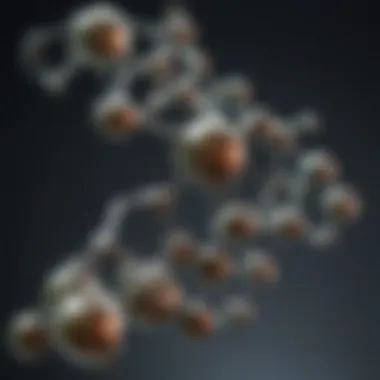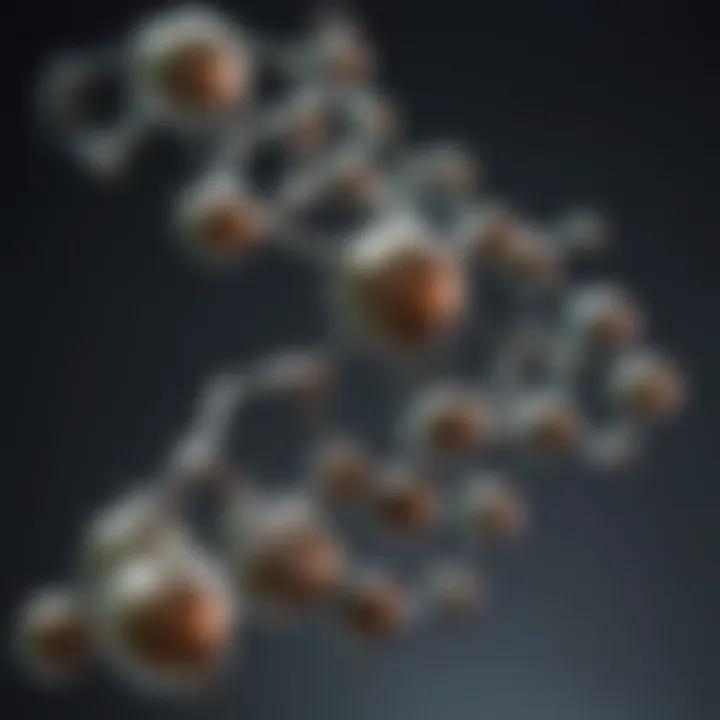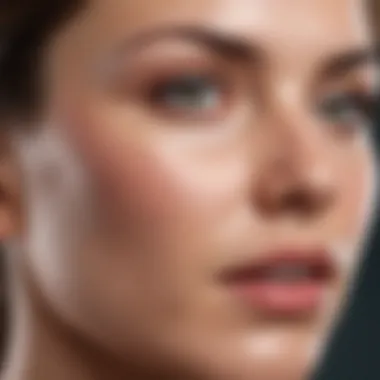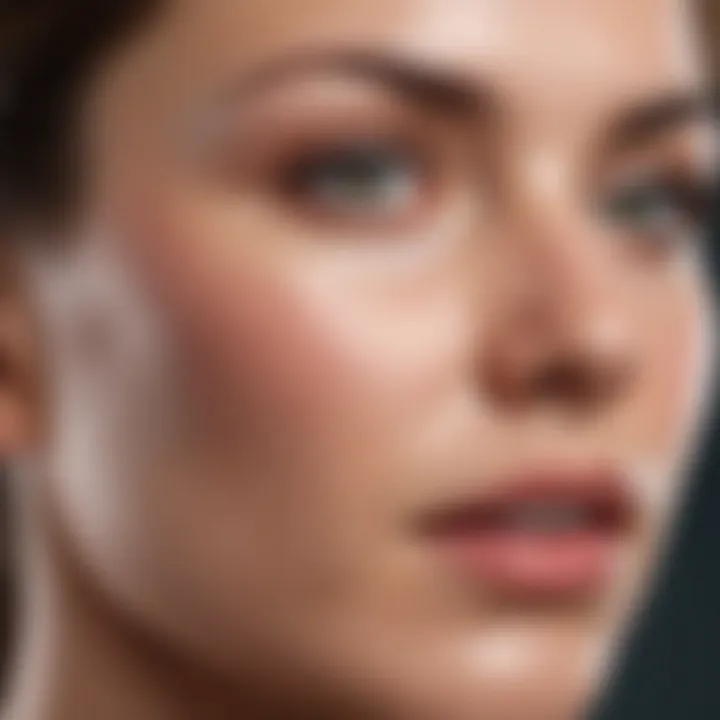Utilizing Tretinoin for Ingrown Hairs: An In-Depth Analysis


Intro
Ingrown hairs represent a common dermal issue, often causing discomfort, irritation, and unsightly appearance. This situation arises when hair follicles become clogged, forcing the hair to grow back into the skin rather than outward. Such conditions can lead to inflammation, resulting in painful bumps and potential scarring. Addressing ingrown hairs efficiently is essential for both aesthetic and health reasons. As dermatological treatments evolve, tretinoin has emerged as a significant player in managing this issue.
Tretinoin, a derivative of Vitamin A, has a well-documented history in acne treatment. However, its mechanism extends beyond acne, lending efficacy in resolving ingrown hairs. To understand how tretinoin can be utilized for such purposes, it is crucial to examine its primary actions, effectiveness, and the potential side effects associated with its use. Hence, this article aims to dissect the role of tretinoin and explore alternative therapies that might better serve individuals struggling with ingrown hairs.
Understanding Ingrown Hairs
Ingrown hairs are a prevalent condition that affects various individuals, notably those who shave or wax. Understanding this issue is essential in advocating for effective treatment options like tretinoin, which can significantly alleviate the problem. By grasping what ingrown hairs are and the underlying factors behind their occurrence, one can appreciate the role of tretinoin better. This section aims to emphasize the significance of comprehending ingrown hairs, their various aspects, and how this knowledge contributes to effective management.
Definition and Causes
Ingrown hairs occur when a hair grows back into the skin instead of rising up from it. This can lead to inflammation, redness, and discomfort. The primary causes of ingrown hairs usually relate to hair removal methods. Shaving, waxing, or tweezing can create sharp edges on the hair, which may curve back towards the skin as it grows. Tight clothing can exacerbate the condition by trapping the hair against the skin, further contributing to the problem.
Factors such as hair type and curliness also play a role in ingrown hairs. For individuals with curly hair, the likelihood of experiencing ingrown hairs increases as the hair's natural tendency is to curl back into the skin.
Risk Factors
Certain groups of individuals may be more prone to developing ingrown hairs. Key risk factors include:
- Hair Removal Techniques: Shaving and waxing are the most common methods linked with ingrown hair development.
- Skin Types: Those with thick, coarse, or curly hair are at a higher risk.
- Clothing Choices: Wearing tight clothing can push hair back into the follicle.
- Improper Grooming: Using dull razors or inadequate shaving techniques can lead to sharp edges on hairs.
Understanding these risk factors enables proactive measures to prevent ingrown hairs, thereby minimizing potential discomfort and the need for treatment.
Symptoms and Diagnosis
Recognizing the symptoms of ingrown hairs is crucial for effective management. Common indicators include:
- Red Bumps: Often accompanied by itching or tenderness.
- Inflammation: Swelling around the hair follicle can signal irritation.
- Pus or Discharge: In some cases, ingrown hairs may become infected and produce discharge.
Diagnosis of ingrown hairs typically involves a physical examination. A dermatologist examines the affected area and evaluates the presentation of the symptoms. In some instances, further diagnostic measures may be taken to rule out other skin conditions that present similarly. Understanding these signs can help individuals seek appropriate treatment earlier, which can lead to better outcomes.
Prolusion to Tretinoin
Tretinoin plays a pivotal role in the management of ingrown hairs, a common concern that impacts both aesthetic appeal and skin health. Understanding this compound is essential for anyone seeking effective treatments. Tretinoin, a derivative of Vitamin A, is often highlighted for its ability to promote skin cell turnover, which may help prevent hair follicles from becoming blocked. This quality is crucial in the context of ingrown hairs, as clogged follicles can lead to irritation and inflammation.
Moreover, tretinoin is regarded not only for its therapeutic effects but also for its broad application in dermatology, including acne treatment and anti-aging purposes. Its relevance in tackling ingrown hairs emanates from a combination of its chemical properties and mechanistic actions. A thorough exploration of these characteristics will illuminate how this medication fits into a comprehensive skincare regimen aimed at reducing the occurrence and severity of ingrown hairs.
Chemical Composition
Tretinoin is essentially all-trans retinoic acid, a potent compound that is both lipid-soluble and biologically active. The chemical formula is C(20)H(28)O(2), and its structural characteristics enable it to penetrate the skin effectively. This penetration is key, as it facilitates interaction with specific nuclear receptors to influence gene expression. The formulation comes in various cream and gel concentrations, allowing for tailored applications depending on the severity of the condition or the sensitivity of the individual's skin.
Unpacking the chemical aspects of tretinoin also reveals its stability profile. Tretinoin is sensitive to light and air, which can impact its efficacy over time. Therefore, proper storage and handling are vital to maintain its potency.
Mechanism of Action
The action of tretinoin centers on its ability to modify the behavior of skin cells. Once applied, it promotes faster skin cell turnover. This increased turnover not only aids in the shedding of dead skin cells but also encourages the growth of fresh, new cells. This process can significantly reduce the risk of hair follicles becoming blocked, which is a primary cause of ingrown hairs.
In addition to cell turnover, tretinoin exerts anti-inflammatory effects. By regulating the expression of several specific proteins involved in inflammation, it can reduce redness and swelling that accompany ingrown hairs. Furthermore, its ability to enhance collagen production contributes to improved skin texture and resilience, making it beneficial in preventing future instances of ingrown hairs.
Historical Context
The introduction of tretinoin into dermatological practice marks a significant milestone in skin health management. Initially, it was hailed as a groundbreaking treatment for acne in the late 1970s. Over the years, researchers recognized its versatility, leading to expanded applications beyond acne.


As dermatologists and researchers studied its effects, the efficacy of tretinoin for conditions like hyperpigmentation and photoaging gained attention. During the 1980s and 1990s, clinical trials began to demonstrate its potential for treating not just acne but also various other skin conditions, paving the way for its current applications.
In summary, the journey of tretinoin from a singular acne treatment to a multifaceted agent in skincare illustrates its importance. Today, it stands as a valuable option in the domain of ingrown hair management, warranting a detailed consideration for individuals affected by this condition.
Application of Tretinoin for Ingrown Hairs
Tretinoin holds significant potential in addressing the issue of ingrown hairs. As a derivative of Vitamin A, its application in skincare is well-documented, particularly in acne and anti-aging treatments. However, its role in managing ingrown hairs is a pertinent topic that necessitates deeper exploration. The effectiveness of tretinoin relies on its ability to enhance skin cell turnover, ultimately preventing hair follicles from becoming blocked.
Through a comparative analysis, tretinoin can be seen as a proactive measure against ingrown hairs. The topical application encourages the shedding of dead skin cells, promoting a smoother skin surface. This reduced incidence of clogged hair follicles leads to fewer ingrown hairs. Additionally, by softening the skin, tretinoin may facilitate the growth of hair, allowing it to emerge properly rather than curling back beneath the skin.
Before implementing tretinoin, it is vital to consider individual skin types and conditions. Consultation with a dermatologist is recommended, as they can provide personalized advice and monitor patient response to the treatment.
Tretinoin is primarily intended for topical use and should be applied under professional guidance to avoid complications.
Scientific Evidence
The scientific foundation for utilizing tretinoin in treating ingrown hairs is gradually consolidating through clinical observations and studies. Research illustrates that the application of tretinoin results in more rapid cell turnover, thereby reducing the risk of hairs becoming trapped below the skin's surface. A study conducted in dermatological settings indicates that patients using tretinoin experienced a notable decrease in the frequency of ingrown hairs compared to those who did not employ this treatment.
Moreover, findings suggest tretinoin’s anti-inflammatory properties help to alleviate irritation caused by ingrown hairs. This effect is crucial since inflammation can exacerbate the issue, creating cycles of discomfort for individuals suffering from this condition. While the volume of research specifically focused on tretinoin’s efficacy for ingrown hairs still requires expansion, existing literature supports its favorable role.
Practical Usage Guidelines
When using tretinoin for ingrown hairs, adhering to certain guidelines is crucial for optimal results. Here are several practical considerations:
- Start Slowly: Begin with a lower concentration to gauge skin tolerance. Gradually increase usage based on dermatologist recommendations.
- Frequency of Application: Typically, tretinoin is applied once daily at night. Consistency plays a vital role in achieving desired results.
- Skin Preparation: Ensure the skin is clean and dry before application. This can enhance absorption and effectiveness.
- Moisturizing: Since tretinoin can lead to dryness, incorporating a non-comedogenic moisturizer is advisable.
- Sun Protection: Being a retinoid, tretinoin increases skin sensitivity to sunlight. Daily application of sunscreen is essential to prevent adverse reactions.
In summary, incorporating tretinoin into one’s skincare routine could provide a significant advantage in managing ingrown hairs, supported by both anecdotal evidence and emerging scientific research. Following the appropriate guidelines fosters both safety and efficacy in treatment.
Efficacy of Tretinoin
Tretinoin demonstrates notable efficacy in treating ingrown hairs, an issue that affects many individuals. It is essential to understand how tretinoin works and its advantages over other treatments. Tretinoin is a topical retinoid that promotes cell turnover and helps to clear clogged follicles. This action not only reduces the occurrence of ingrown hairs but also improves overall skin texture.
Comparison with Other Treatments
When considering treatments for ingrown hairs, it is vital to compare tretinoin with alternative options. The common methods include:
- Exfoliating scrubs: These products help to remove dead skin cells but may not deeply penetrate follicles.
- Salicylic acid: This beta hydroxy acid can help dissolve the keratin plugs but does not have the same regenerative benefits as tretinoin.
- Laser hair removal: While effective, this can be costly and not all individuals are suitable candidates.
- Antibiotics: Often prescribed for infections resulting from ingrown hairs, they address symptoms but do not prevent future occurrences.
Tretinoin, in this regard, stands out. Its unique ability to regulate skin cell production and effectively eliminate blockages helps to offer fewer recurrences of ingrown hairs. Studies show that tretinoin is more effective than common over-the-counter products in promoting skin renewal and health.
Patient Outcomes and Testimonials
Empirical evidence highlights positive patient outcomes when using tretinoin for ingrown hairs. Many patients have reported significant improvements, stating that the frequency of ingrown hairs decreased markedly. Here are some summarized experiences:
- Enhanced skin clarity: Users noted a noticeable reduction in bumps and dull skin, often attributing this change to the regular use of tretinoin.
- Fewer incidents of infection: Many shared that they experienced less irritation and fewer infections, leading to a more comfortable skin condition.
- Overall satisfaction: Testimonials often highlight a higher satisfaction with their grooming routines, as the ugly effects of ingrown hairs became less pronounced.
Several studies have compiled feedback from users, illustrating a strong correlation between tretinoin usage and improvement in skin issues linked to ingrown hairs. Medical professionals recommend it as a first-line treatment, noting its preventive capabilities alongside its therapeutic effects.
"Tretinoin not only changed how I manage my skin but also boosted my confidence. I rarely deal with ingrown hairs anymore, which transformed my grooming routine and overall comfort."
– A satisfied user of tretinoin.
Through thorough assessment of tretinoin's efficacy and the positive feedback from patients, it becomes evident that this treatment plays a significant role in managing ingrown hairs effectively.
Potential Side Effects


Understanding the potential side effects of tretinoin is crucial when considering its use for treating ingrown hairs. While this medication offers many benefits, its application is not without risks. Awareness of these side effects can help patients make informed decisions and prepare for any adverse reactions they may experience.
Tretinoin can cause various physical reactions in individuals. Unlike some topical agents, it can provoke more significant responses, especially in those who have sensitive skin. Among the reactions to be aware of, redness, peeling, and irritation are the most common. Also, users may notice a burning sensation upon application. These side effects are often a result of the active compound's potent nature and its effect on skin cell turnover.
Another potential side effect is sun sensitivity. Tretinoin increases the skin's susceptibility to UV rays. This may lead to heightened risks of sunburn. Therefore, when using tretinoin, it’s particularly important to stay vigilant about sun protection.
In addition, prolonged use of tretinoin may also lead to excessive dryness or flaking of the skin, which can be uncomfortable. Patients should be cautious and monitor their skin condition closely to determine their tolerance level.
"Staying aware of potential side effects leads to better management and improves treatment outcomes."
Ultimately, recognizing these effects is critical for enhancing patient safety and ensuring that tretinoin remains a viable option in the treatment of ingrown hairs.
Common Reactions
The most observed reactions to tretinoin include:
- Redness: Often appears shortly after applying the cream or gel, indicating irritation.
- Peeling: A natural process where layers of skin shed due to the stimulation of cell turnover.
- Burning Sensation: This may occur during the initial uses as the skin adjusts to the medication.
- Dryness: Can lead to discomfort; skin may feel tight and sensitive.
These reactions generally subside as the skin adapts to the treatment. However, patients should not disregard persistent symptoms, as they might indicate an adverse reaction requiring intervention.
Managing Adverse Effects
Management of adverse effects is essential to ensure continued use of tretinoin. Here are some strategies:
- Start Slowly: Begin with a lower concentration of the medication or use it less frequently to allow the skin to acclimate.
- Hydration: Applying a gentle moisturizer can alleviate dryness. It is advisable to use non-comedogenic products.
- Avoiding Irritants: Steer clear of other active ingredients, such as alpha hydroxy acids or benzoyl peroxide, during initial treatment phases to minimize irritation.
- Sun Protection: Use broad-spectrum sunscreen with a high SPF daily. This is critical for individuals using tretinoin due to increased sun sensitivity.
- Consultation: Regular follow-ups with a dermatologist can help monitor skin responses and adjust treatments as needed.
In summary, while potential side effects of tretinoin are significant, managing these reactions can help sustain its usage for treating ingrown hairs effectively.
Who Should Consider Tretinoin?
The use of tretinoin for treating ingrown hairs warrants careful consideration of its potential benefits and the individual characteristics of patients. Tretinoin is a potent retinoid that enhances skin cell turnover, making it an appealing option for those suffering from conditions related to hair growth and skin blockage. However, the suitability of this treatment must be evaluated on a case-by-case basis, as not all individuals may respond positively to its application.
Patient Eligibility Criteria
When assessing the eligibility for tretinoin, several factors come into play. These include age, skin type, severity of ingrown hairs, and the presence of other skin conditions. Typically, candidates for tretinoin therapy include:
- Individuals with recurrent or chronic ingrown hairs: Those who have experienced a history of ingrown hairs may find that tretinoin can reduce the frequency of flare-ups.
- Patients with resilient skin types: Those with oily or combination skin may respond better to tretinoin due to their skin's ability to tolerate retinoids.
- Patients willing to modify their skincare routine: Tretinoin requires consistent and correct application. Therefore, individuals who are prepared to commit to a structured skincare regimen may achieve better results.
Nonetheless, not all patients are suitable candidates. People with sensitive skin, particularly those prone to irritation or severe dryness, may find that tretinoin exacerbates their condition. Furthermore, pregnant or breastfeeding individuals should avoid using tretinoin due to potential risks to fetal development.
Consultation with Dermatologists
Before initiating treatment with tretinoin, a consultation with a dermatologist is crucial. The dermatologist will evaluate the patient's skin condition and discuss potential treatment plans, including the use of tretinoin. Key aspects of this consultation include:
- Assessment of skin type and condition: A dermatologist can determine whether an individual's skin is suitable for tretinoin, exposing any underlying issues that could complicate treatment.
- Discussion of treatment expectations: Patients should express their goals clearly, allowing the dermatologist to provide realistic outcomes regarding the efficacy of tretinoin for their specific situation.
- Alternative therapies: The dermatologist can suggest other options if tretinoin is not suitable or if the patient is looking for a more balanced multi-faceted approach. This may include over-the-counter options and professional procedures.
Thus, making an informed decision about utilizing tretinoin necessitates a thorough understanding of personal skin characteristics and professional advice.
It is vital to follow medical guidance closely when it comes to skin treatments, particularly with potent ingredients like tretinoin.
Alternative Treatments
The significance of exploring alternative treatments for ingrown hairs cannot be overstated. While tretinoin plays a vital role, many individuals seek other methods to manage this skin condition. Understanding the diverse options available can help patients make informed decisions tailored to their specific needs. This section examines both over-the-counter solutions and professional procedures.


Over-the-Counter Options
For those looking for immediate relief from ingrown hairs, over-the-counter options can provide a practical alternative. Various creams, gels, and exfoliating products are readily accessible at pharmacies and online.
- Salicylic Acid: This beta hydroxy acid helps to exfoliate dead skin cells. It can prevent hair follicles from clogging, thereby reducing the occurrence of ingrown hairs.
- Glycolic Acid: A type of alpha hydroxy acid, glycolic acid enhances skin peeling and improves overall skin texture. Regular use may decrease the likelihood of ingrown hairs forming.
- Tea Tree Oil: Known for its antibacterial properties, tea tree oil can soothe skin irritations and reduce inflammation associated with ingrown hairs. It’s essential to dilute it with a carrier oil before application to prevent skin irritation.
Patients should always read labels carefully and consider consulting with a dermatologist before starting any new treatment. Individual reactions to products can vary, and some might find specific ingredients more beneficial based on their skin type.
Professional Procedures
For more persistent cases of ingrown hairs, professional treatments may be necessary. These procedures offer targeted solutions under the supervision of qualified dermatologists.
- Laser Hair Removal: This procedure permanently reduces hair growth in targeted areas, thus decreasing the chances of ingrown hairs forming in the future. It is particularly effective for individuals with darker hair and lighter skin.
- Chemical Peels: Dermatologists can administer chemical peels that utilize stronger formulations than over-the-counter options. This treatment removes the outer layer of skin, helping hair follicles to remain clear.
- Extraction: In some cases, a dermatologist may perform manual extraction of ingrown hairs. This process can provide immediate relief and prevent further irritation.
It is important to assess the patient’s skin type and hair characteristics before deciding on professional treatments. Knowing the potential benefits and risks involved will help in making educated choices about skin care.
Preventive Measures for Ingrown Hairs
Preventive measures for ingrown hairs play a critical role in dermatological care. By focusing on proactive strategies, individuals can significantly reduce the occurrences of this common skin issue. Understanding and implementing these measures not only alleviates the discomfort associated with ingrown hairs but also promotes overall skin health.
Effective prevention requires awareness of grooming habits and skin care routines. These strategies can assist in minimizing irritation and maintaining clear pores, both of which are essential for avoiding the complications that arise from ingrown hairs. Below, we delve into specific grooming techniques and skin care routines that can lead to better outcomes.
Proper Grooming Techniques
Proper grooming techniques are foundational in the prevention of ingrown hairs. Adopting the right methods can help avoid hair from curling back into the skin. Here are some critical points to consider:
- Choose the Right Tools: Use sharp razors or clippers for hair removal. Dull tools can cause tugging and increase the risk of irritation.
- Shave in the Right Direction: Always shave in the direction of hair growth. This reduces the chance of the hair snapping and turning back into the skin.
- Avoid Tight Clothing: After hair removal, avoid tight-fitting clothes in areas where you shaved or waxed. This reduces friction and allows the skin to breathe.
It is also wise to not shave too often. Give the skin time to recover between grooming sessions, which can help prevent irritation.
Skin Care Routines
A consistent skin care routine supports skin health and can prevent ingrown hairs. Proper skin maintenance helps keep the hair follicles clear and reduces the chances of hairs becoming trapped. Some important aspects of skin care routines include:
- Exfoliation: Gently exfoliating the skin a few times a week removes dead skin cells, helping to keep hair follicles clear. Consider using chemical exfoliants that are less abrasive.
- Moisturization: Keeping the skin hydrated can reduce dryness and flakiness, which may exacerbate ingrown hairs. Use non-comedogenic moisturizers.
- Active Ingredients: Look for skin care products that contain salicylic acid or glycolic acid, which can help keep pores clear and reduce inflammation.
In summary, preventive measures for ingrown hairs encompass thoughtful grooming techniques and diligent skin care routines. By addressing these elements, individuals can make substantial progress in controlling and preventing ingrown hairs.
"An ounce of prevention is worth a pound of cure."
Implementing these strategies not only aids in the prevention of ingrown hairs but also promotes a healthier skin environment overall.
Ending
Understanding the use of tretinoin specifically for treating ingrown hairs is crucial for both patients and healthcare providers. This article underscores several essential elements about the effectiveness and considerations surrounding this treatment option.
Summary of Points Discussed
Throughout the article, we examined the mechanism of action of tretinoin, highlighting its effect on skin cell turnover. The discussion included a detailed look at scientific evidence supporting its efficacy compared to other treatments. We explored practical guidelines for its application, covering dosage and frequency. The potential side effects were analyzed, providing insights into common reactions and tips for managing these adverse effects. We also addressed eligibility criteria for patients considering tretinoin and emphasized the importance of professional consultation in navigating treatment options.
In discussing preventive measures, we highlighted proper grooming techniques and suitable skin care routines that can significantly reduce the occurrence of ingrown hairs. The discussion also encompassed various alternative treatments, giving readers a broader view of options available in tackling this issue.
Future Directions in Research
As the understanding of skin conditions evolves, further research is highly needed in the area of tretinoin and its role in dermatological care. Future studies could focus on long-term effects of tretinoin treatment specifically for ingrown hairs. There is a potential to explore combinations of therapies, integrating tretinoin with other treatment modalities to enhance efficacy. It would also be beneficial to examine the effects of tretinoin on different skin types and its interactions with various products used in skin care.
Moreover, patient-reported outcomes should be documented to quantify satisfaction and effectiveness of treatments. This could provide valuable data for clinicians and help in tailoring individualized treatments for patients suffering from ingrown hairs.
Overall, continued exploration and assessment of tretinoin in clinical settings is essential to refine treatment practices, ensuring that patients have access to the most effective and safe options available.



